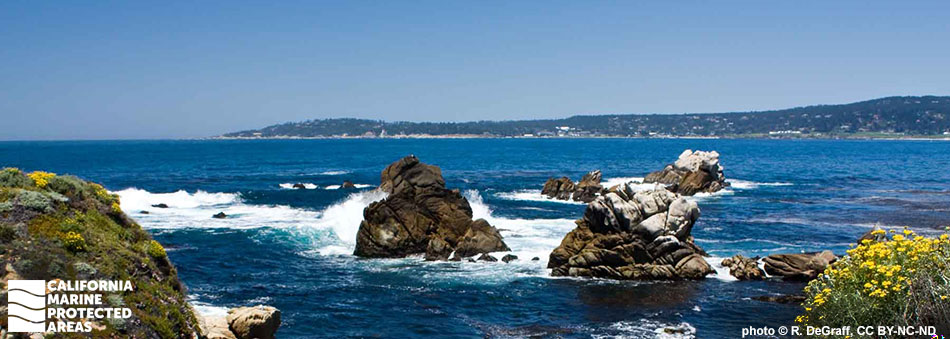
Overview
Point Lobos State Marine Reserve (SMR) and Point Lobos State Marine Conservation Area (SMCA) are a pair of marine protected areas (MPAs) that safeguard the fascinating underwater terrain and spectacular marine life adjacent to Point Lobos State Natural Reserve on shore. Located south of Monterey Bay, these MPAs together encompass almost 14 square miles of habitat from shore to depths of around 1,800 feet.
A portion of the Point Lobos SMR has been protected since 1963, which makes it one of the oldest MPAs in California. Point Lobos SMR offers a glimpse of what younger SMRs may look like in the future. This 5½ square mile SMR includes a small sliver of the Carmel Submarine Canyon, sandy seafloor, extensive rock formations, surfgrass beds, and kelp forests that are home and hunting grounds to an abundance of large, mature fishes such as lingcod and blue rockfish, and invertebrates including sponges, gorgonians, and colorful nudibranchs (sea slugs). Seaward of the SMR, the nearly 8½ square mile SMCA protects sandy seafloor habitat, rocky reefs, and about one-third of a square mile of the Carmel Submarine Canyon.
With their unparalleled species abundance and biodiversity, these MPAs offer spectacular wildlife viewing both above and below the ocean surface. On land, Point Lobos SMR's beaches and rocky intertidal areas are within easy reach for those interested in exploring them, while offshore, scuba and free divers will find extensive kelp forests, rocky reefs, and the deep waters of the Carmel Submarine Canyon. World-class scuba diving, kayaking, hiking, and wildlife viewing make the MPAs and neighboring State Natural Reserve extremely popular destinations.
Regulations
Point Lobos SMR
It is unlawful to injure, damage, take, or possess any living, geological, or cultural marine resource.
California Code of Regulations Title 14, Section 632(b)(81)(opens in new tab)
Point Lobos SMCA
It is unlawful to injure, damage, take, or possess any living, geological, or cultural marine resource, EXCEPT:
Recreational and commercial take of salmon and albacore is allowed. Commercial take of spot prawn is allowed.
California Code of Regulations Title 14, Section 632(b)(82)(opens in new tab)
Quick Facts
Point Lobos SMR
MPA size: 5.5 square miles
Shoreline span: 4.5 miles
Depth range: 0 to 408 feet
Habitat composition*:
- Rock: 4.80 square miles
- Sand/mud: 2.71 square miles
Point Lobos SMCA
MPA size: 8.47 square miles
Depth range: 268 to 1,823 feet
Habitat composition*:
- Rock: 0.62 square miles
- Sand/mud: 7.84 square miles
*Habitat calculations are based on 3-dimensional area and may exceed the total MPA area listed above.